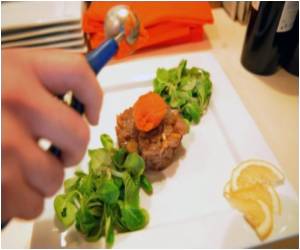
His goal was to expose them to a fundamental piece of French cuisine and cultural heritage before introducing them to his renowned Mediterranean and Japanese fusion.
The more adventurous were impressed. The others simply had their appetite whetted for a truly excellent dinner.
Matsushima, 35, was the first Japanese chef to receive the prestigious L'Ordre des Arts et Des Lettres from the French government.
He decided he wanted to become a chef while watching a Japanese chef preparing French cuisine on television when he was just 10 years old. He studied classic French cuisine at Tsuji in Tokyo and moved to Nice at the age of 20.
"I was drawn to the sun," he said with a smile.
Advertisement
Now he splits his time between Nice and Tokyo, where he has earned another Michelin star for his Restaurant-I.
Advertisement
"One of the most important jobs is understanding the products," Matsushima told AFP.
"Even if the taste is a little different than what we use in France, it's really not a big deal. The chef is there to reach the origin of the flavor. And even if you don't get precisely there, it's fine. You do the best you can with the products you have. That's all."
The hardest things to reproduce are bread -- which is so dependent upon the water - and charcuterie like sausages and pate, said Ageneau, who was born in the Vendee region of France.
Reasonable substitutes for most other fresh ingredients can be found by developing relationships with local farmers and suppliers while oils, spices and other staples can easily be imported if need be.
"Even if there's a slightly different taste, when you start with a high quality product it's easy to adapt," Ageneau said.
"Maybe for a guy who's lived in the same tiny corner of France all his life, there would be a bit of a shock at first, but for us it's just normal life."
It was a far from typical evening at Chicago's Paris Club, where a sold-out crowd shared tables of eight at the first of a series of guest chef events.
A sea urchin mousse opened the meal, followed by asparagus on a bed of sunchoke topped with edible flowers, which led to a loup du mer.
Spaghetti-like strands of potato were wrapped around the delicate sea bass, which was then deep fried and served on a mushroom puree topped with slivers of truffles and parmesan and finely shaved greens.
Then came Matsushima's signature dish -- a mille-feuilles of beef tenderloin with a delicate dusting of wasabi and a side of tempura.
A strawberry sorbet tart with thyme ice cream served on a slate tile capped the meal.
In the kitchen below, Matsushima was nearly silent as the courses were prepared.
Like all great chefs, he had trained even this temporary crew well and completed the bulk of the preparation earlier in the day. Unlike many, his approach is Zen-like in its calm precision.
It is in keeping with his gastronomical philosophy of simplicity.
"You can't imagine, you can't create in stress," Kei said. "Sometimes you manage, but it's complicated."
Source-AFP









